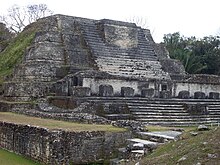| Pre-Columbian Era | |||
|---|---|---|---|
| 20000 BC – 1500 AD | |||
 | |||
| Including |
| ||
| Key events |
| ||
Chronology
| |||
| History of Belize | ||||||||
|---|---|---|---|---|---|---|---|---|
 | ||||||||
|
||||||||
|
| ||||||||

The Pre-Columbian Belize history is the period from initial indigenous presence, across millennia, to the first contacts with Europeans - the Pre-Columbian or before Columbus period - that occurred on the region of the Yucatán Peninsula that is present day Belize.
Belize's history begins with the Palaeoindians. They were nomadic people that arrived in the Asia to the Americas migration across the frozen Bering Strait, perhaps as early as 35,000 years ago. In the course of many millennia, their descendants settled in and adapted to different environments in the Americas, creating many cultures in North America, Central America, and South America. The Mayan culture emerged in the lowland area of the Yucatán Peninsula and the highlands to the south, in what is now southeastern Mexico, Guatemala, western Honduras, and Belize.[1] Between about 2500 BC and AD 250, the basic institutions of Mayan civilization developed. The peak of this civilization occurred during the Classic Period, which began about AD 250.[1]
Many aspects of this culture persist in the area despite nearly half a millennium of European presence. All evidence, whether from archaeology, history, ethnography, or linguistics, points to a cultural continuity in this region. The descendants of the first settlers in the area have lived there for at least three millennia.[1]
- ^ a b c Bolland, Nigel (1993). "Belize: Historical Setting". In Guyana and Belize: Country Studies (Tim Merrill, editor), Library of Congress Federal Research Division. This article incorporates text from this source, which is in the public domain.